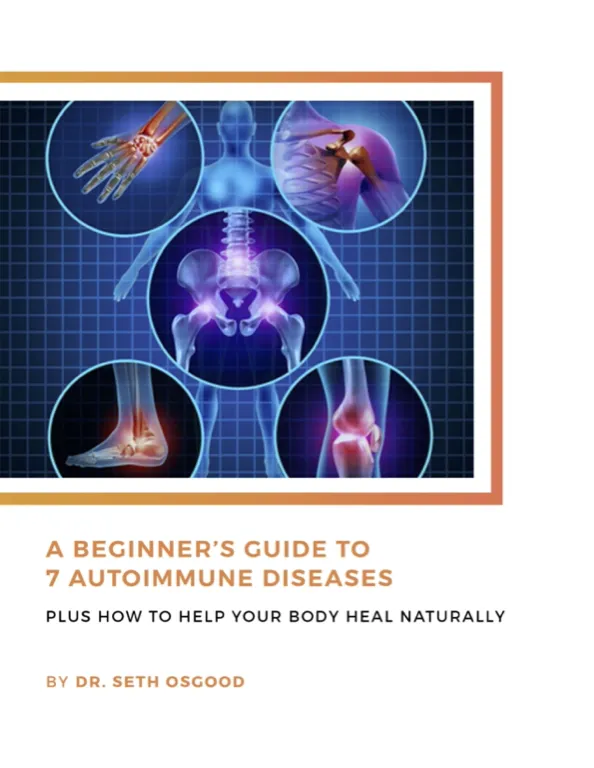Lyme disease is on the rise in the US, yet cases are often missed and there is a lot of misinformation and confusion on the topic.I have seen the effects of Lyme disease firsthand in the clinic and I know the toll it takes on patients and their families.
In order to help you and your loved ones spot Lyme early and treat it properly (or better yet, prevent it!), I created this comprehensive resource that is easily shareable. Check it out and bookmark it for reference later.
What is Lyme Disease and How is it Transmitted?
Lyme Disease is caused by a bacterial spirochete called Borrelia burgdorferi and is transmitted primarily by tick bites.
When a tick lands on a human, it attaches to the skin and releases a numbing agent to prevent you from feeling its bite. It then inserts a tiny feeding tube and secretes a cement-like substance to attach itself to your skin. It draws blood from you over the next several days, during which time any pathogens it’s carrying are transmitted to you via saliva.
Unfortunately, ticks are extremely small and you often do not feel their bite thanks to the numbing agent, so people are often unaware they have been bitten.
What are the Symptoms of Lyme Disease?
You may have heard that the first sign of Lyme disease is a bullseye-shaped rash. However, it’s estimated that 30% of Lyme cases do not present with this telltale rash at all. This means that even if you do not recall a tick bite or see a bullseye rash, you could still have Lyme disease!
To further complicate things, the symptoms of Lyme can be very vague and overlap with other illnesses, including the flu and autoimmune disease. This is why Lyme’s nickname is “The Great Imitator.”
Here are a few signs of early Lyme disease to look for.
Acute Lyme Disease Symptoms:
- Fatigue
- Migratory muscle and joint pain
- Headaches
- Neck pain
- Memory challenges
- Sleep issues
Symptoms of Chronic Lyme Disease:
It’s quite common for Lyme to either go undetected or not respond to initial treatment (more on this below). In these cases it can become chronic, and lead to any of these symptoms.
- Depression, anxiety, or mood swings
- Brain fog
- Cognitive decline and Alzheimer’s
- Neuropathy (numbness and tingling)
- Immune dysfunction
- Cardiovascular symptoms (chest pain, palpitations, shortness of breath)
Why Lyme Disease Is On the Rise
Many people think that Lyme disease is relatively rare, but it’s actually one of the fastest-growing infectious diseases in the US. There are an estimated 329,000 new cases each year, which is 10x higher than the Centers for Disease Control predicted just a few years ago and a 320% increase from the 90s.
Another common misconception is that Lyme is only present in the northeast. Due to the factors below, Lyme is now found all over the country and has been diagnosed in all 50 states. Unfortunately, many doctors hold outdated views and brush off patients with Lyme concerns if they are outside the “typical” geographic area for Lyme.
Here are a few reasons why Lyme cases are increasing:
- Urban and suburban development is pushing further into natural areas, putting people in closer proximity to ticks
- Migratory birds, deer, and traveling people and pets are carrying infected ticks across the country
- Tick season has grown longer due to climate change, giving ticks more opportunities to infect people
The Challenges of Treating Lyme Disease
I’ll be honest with you, Lyme is one of the most complex conditions to treat. We have helped numerous GrassRoots patients recover from Lyme, but it takes time and hard work from both the patient and the provider. Here are a few reasons it can be so tricky to treat.
Difficult to Diagnose
Many providers don’t even consider a Lyme diagnosis if the patient doesn’t recall a tick bite, present with a bullseye rash, or live in the northeast. If a practitioner does suspect Lyme, they typically use two different blood tests that look for antibodies and reactivity to Lyme bacteria. These tests have low sensitivity and only pick up 30 to 40% of early Lyme cases. They also rely on subjective interpretations. This means there are lot of false negatives in Lyme testing.
Disrupts Immune Function
The bacteria Borrelia burgdorferi sets off a cascade of systemic inflammation where pro-inflammatory cytokines attack tissue everywhere from the heart to the brain. It also suppresses your immune system, which lowers your defenses and allows the bacteria to multiply quickly and spread throughout your body.
To further complicate things, it can lead to autoimmune disease by hiding within your cells, causing your immune system to attack your tissues when it goes to kill off the Lyme disease.
Comes with Co-Infections
Ticks infected with Lyme are often carrying other bacterial, viral, or parasitic infections as well. Some are pathogenic themselves and cause their own set of symptoms, while others act alongside Borrelia burgdorferi to create a biofilm that makes them resistant to antibiotics.
Common co-infections include:
- Bartonella – Causes pain in the abdomen and joints, sore throat, and neuropsychiatric disorders in some cases
- Babesia – May present as anxiety, drenching sweats, and a racing heart
- Mycoplasma – Linked specifically to autoimmune reactions
- Rickettsia – Causes flu-like symptoms and a red-spotted rash on palms
- Chlamydia infections – Causes upper-respritory infections, pneumonia, and is also linked to autoimmune disease
Adapts to and Resists Antibiotics
The most commonly prescribed antibiotic for Lyme disease is doxycycline, but studies show Borrelia burgdorferi has the ability to alter its genetic expression in response to this drug. Research shows it may also become resistant to the antibiotics amoxicillin and ceftriaxone.
Strategies to Prevent Lyme Disease
As with all things related to health and wellness, prevention is the best strategy! Two years ago I started making DIY Tick Tubes to keep ticks away from our property and protect my five kiddos. They’re essentially just toilet paper rolls filled with cotton balls soaked in permethrin and they’ve worked phenomenally. You can also buy ready-made ones here.
Another option is to treat your outdoor socks and shoes with permethrin. This week I had local Lyme expert, Dr. Alexis Chesney on the GrassRoots podcast and she shared that she likes to utilize InsectShield.com to either purchase pretreated socks or send clothing off to be treated.
Other precautions include sticking to trails and avoiding tall grass when out in the woods, performing “tick checks” on your whole family (including pets) after outings, and utilizing lemon eucalyptus oil as a natural bug spray.
The Best Testing for Lyme Disease
Tick Testing
If you find a tick attached to you, you’ll want to remove it and send it off to be tested for Lyme and the common co-infections. Use a pair of tweezers or the O’Tom Tick Twister to gently lift and remove the tick. Squeezing it too hard can cause it to regurgitate more pathogen-carrying saliva. Once removed, send the tick off using TickReport.com and you’ll receive your results in 72 hours.
Blood Testing
As I mentioned earlier, conventional Lyme testing, which includes an ELISA and Western Blot blood test, is less than 50% accurate. Obviously, that is not very reliable and leaves a lot of patients with undetected cases that go on to become chronic Lyme with serious symptom involvement. In our clinic, we use a test called the Lyme ImmunoBlot from IgeneX that has a 90% sensitivity rating for Lyme.
It is rather expensive, so we make the decision with the patient after taking a close look at their symptoms and overall health picture to weigh the pros and cons of testing.
A Functional Medicine Approach to Treating Lyme Disease
Lyme is not like other bacterial infections, it causes systemic inflammatory effects throughout the body and immune dysfunction that makes it difficult to eradicate. This is why a simple course of antibiotics is often unsuccessful in completely resolving Lyme.
In functional medicine, we take a whole-body approach that addresses all of the dysfunction caused by Lyme and supports your body’s natural ability to fight off the disease and restore balance. The protocol is highly personalized to each patient, but here’s a high-level overview.
Support the Immune System
First and foremost, you want to bolster your defense. Lyme raises inflammation and suppresses immune function, so your immune system needs extra support in the form of a nutrient-rich, anti-inflammatory diet, a low-tox environment, and possibly immune-supporting supplements.
Repair Your Gut
Your GI tract is home to nearly 80% of your immune system and many tick-borne co-infections can disrupt your microbiome. Take steps to repair your gut through diet and lifestyle and consider implementing supplements to restore your microbiome.
Use Antimicrobials
Pharmaceutical and herbal antimicrobials are still valuable tools to kill off the bacteria, they just aren’t our only tool.
Consider Low-Dose Immunotherapy
Low-dose immunotherapy or LDI is designed to retrain your regulatory T cells so your immune system responds appropriately to threats. In some patients with chronic Lyme, their immune systems are stuck in “attack mode”, which is why their symptoms linger long after the bacteria have been eradicated.
In an LDI for Lyme protocol, a patient is given extremely diluted doses of biologically inert Borrelia burgdorferi and 74 common co-infections.Once the patient reaches their therapeutically correct dose, their immune system switches “off” and the inflammatory symptoms subside.
Support Detoxification
In patients with hard-to-treat Lyme, they may also be suffering from mold or mycotoxin exposure that is further suppressing immune function. Eliminating exposures and supporting detoxification through supplements, infrared sauna use, and PEMF therapy can help these patients achieve long-term recovery.
Explore Cutting-Edge Treatment Options
In the last few years, several therapies have been employed “off label”, meaning outside of their narrow intended use, to help patients recover from Lyme. These lesser-known, yet evidence-based treatments have been widely studied and are often more prevalent in European countries, to great success. Here are a few we have used and/or offer to members of our Adaptation Program.
- Peptide Therapy – Peptides are short chains of amino acids that your body uses as signaling agents. With peptide therapy, you receive a boost of targeted peptides that may improve certain functions. Peptide therapies that may be helpful for Lyme include Thymosin Alpha-1 (immune modulation), LL37 (anti-microbial), Thymosin Beta-4 and BPC-157 (anti-inflammatory), ARA-290 (neuropathy recovery).
- Hyperbaric Oxygen Therapy – HBOT increases oxygenation throughout the body with a whole host of benefits, including decreasing inflammation, regulating immune function, and supporting cognitive health. Check out this podcast episode to learn more.
- Low-Dose Naltrexone – This medication helps modulate the immune response and is often used for patients with autoimmune disease. It may be particularly helpful in the case of chronic Lyme or when patients have both Lyme and autoimmunity.
If you’re struggling with Lyme, or think you might be, I highly recommend working with a functional medicine provider who is experienced with complex Lyme. It’s a unique beast that sometimes requires creativity and outside-of-the-box strategies, along with a strong mindset and commitment from the patient.
We have worked with numerous Lyme patients in our Adaptation Program and seen some incredible recoveries. If you’re interested in this comprehensive, hands-on approach, check out our Adaptation Program and request a discovery call.
About the Author: Dr. Seth Osgood is a Doctor of Nursing Practice, Board Certified Family Nurse Practitioner and Institute of Functional Medicine (IFM) Certified Practitioner. Dr. Osgood received his post-graduate training in Functional Medicine through the IFM and from working with Dr. Amy Myers. He has helped people from around the world improve their health utilizing a Functional Medicine approach.






0 Comments